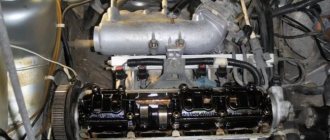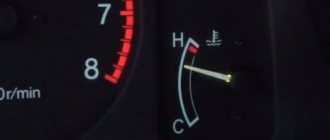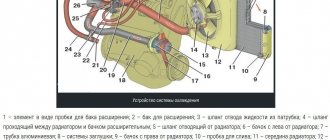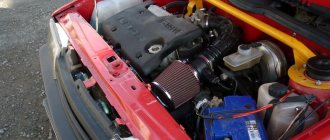What should the engine operating temperature be?
If we take the information from the international convention of automobile manufacturers dated December 1, 1992, then the uniform standard for engine operating temperature is considered to be 90 degrees Celsius.
With such indicators, the engine operates as efficiently as possible and does not create residual negative effects. When switching to more advanced engine manufacturing technologies in 2004, it was accepted that a specific indicator of this indicator cannot be held in one position, and therefore they made a gradation of acceptable standards, which amounted to 85-105 degrees Celsius.
According to data from the manufacturer AvtoVAZ, on a 16-valve VAZ-2112 engine, the operating temperature of the engine is considered to be 87-103 degrees Celsius.
At this temperature, all systems function normally, and the motor is not subject to negative factors and consequences.
More about markings
Class G11
Antifreezes marked G11 are antifreezes based on silicates and inorganic additives. Used for cars up to 1996. And now the main thing is that Antifreeze has the same composition! Therefore, remember, coolants Antifreeze and Antifreeze brand G11 are the ONE AND THE SAME!
G11 antifreeze (Tosol) is designed for older cars with a large cooling system. They create a protective film throughout the cooling system that protects parts from corrosion, but this protection has a drawback - this protective film reduces thermal conductivity. Therefore, in a modern car with thin cooling system channels, G11 is not suitable, because engine cooling deteriorates. In addition, the boiling point of G11 antifreeze is 105 degrees. The maximum service life of such coolants is 2-3 years or up to 50-80 thousand km. mileage
Class G12
G12 antifreezes have a completely different composition of additives than G11 (Antifreeze) - these are carboxylate organic compounds. Used on high-speed, heat-loaded vehicles. Boiling point is 115-120 degrees. G12 does not create a protective film throughout the entire system, but only acts on areas of possible corrosion. Therefore, the thermal conductivity of G12 antifreeze is higher than that of G11. The service life of the G12 is 5 years or 250 thousand km. mileage
Class G12+
G12+ antifreeze is slightly different from G12, the same carboxylate organic antifreeze. We can say that this is the next generation after the G12, used on modern cars. The operating method and service life are similar to G12.
Class G13
G13 antifreeze is the newest generation of coolant; it is no longer based on ethylene glycol like G11, G12, G12+, but on propylene glycol. This antifreeze is less toxic and decomposes faster, i.e. causes less harm to the environment during disposal or leakage, but is also more expensive. Used for high-performance engines. Engines of sports cars, motorcycles, etc. for engines operating in extreme conditions. They say they don’t make it in the CIS countries yet (at the time of writing this article (2014)) due to its high cost, but I’ve already seen it on sale, although I didn’t pay attention to the manufacturer.
Cooling system design
The engine cooling system has many components that are interconnected, and if one fails, the entire system will not be able to function. So, let's look at the location diagram and decoding of the indicators for the cooling system of a 16-valve engine.
1 – heater radiator; 2 – steam removal hose of the heater radiator; 3 – outlet hose; 4 – supply hose; 5 – coolant temperature sensor (in the block head); 6 – pump supply pipe hose; 7 – thermostat; 8 – filling hose; 9 – expansion tank plug; 10 – coolant level indicator sensor; 11 – expansion tank; 12 – exhaust pipe; 13 – liquid chamber of the carburetor starting device; 14 – radiator outlet hose; 15 – radiator supply hose; 16 – radiator steam outlet hose; 17 – left radiator tank; 18 – sensor for turning on the electric fan; 19 – fan electric motor; 20 – electric fan impeller; 21 – right radiator tank; 22 – drain plug; 23 – electric fan casing; 24 – timing belt; 25 – coolant pump impeller; 26 – supply pipe of the coolant pump; 27 – coolant supply hose to the throttle pipe; 28 – coolant drain hose from the throttle pipe; 29 – coolant temperature sensor in the outlet pipe; 30 – radiator tubes; 31 – radiator core.
Diagnostics using ODB-2 scanner
The general technical condition of the car can always be checked using a personal diagnostic car scanner. Among the options available on the market, we recommend paying attention to the Korean-made Scan Tool Pro Black Edition scanner. This model is perfectly compatible with most domestic and foreign cars.
A special feature of the device is full automatic diagnostics. Unlike analogues, this auto scanner is capable of diagnosing not only the engine, but also ABS, gearbox, transmission, airbag, air conditioning system, etc. All gauges, oil pressure, temperature and much more are available.
Cooling radiator
As practice shows, this part lasts quite a long time. The main cause of failure is clogged internal channels. So, if the blockage is sufficiently dense, the engine begins to heat up, the high pressure created by the pump can lead to a rupture of the tube and the radiator will leak.
Some car enthusiasts have it soldered and cleaned, but as practice shows, after a short period of time, a leak forms again. Therefore, if this part fails, it must be replaced with a new one.
Common Causes
As you know, the VAZ 2110 is equipped with two types of engines: with 8 and 16 valves. There are several main and most common reasons why such overheating of power units occurs.
- Low coolant level in the system
- Faulty thermostat
- Radiator cooling fan is faulty
- The temperature sensor of the power supply, etc. is faulty.
Let's look at each of the causes and solutions to these problems separately.
Engine tens
Low coolant level
Coolant plays a huge role in the operation of the cooling system. A special substance, namely antifreeze, is poured into the expansion tank.
Under normal conditions, the coolant level should be at the MAX mark on the tank body. This means the container is about 50-60 percent full.
If there is no such mark on the tank, use the clamp as a guide. The liquid should reach the top edge.
- If the engine is overheating, try adding the missing amount of coolant to the optimal level.
- If you haven't changed the coolant in a while, it's best not to add new coolant, but simply replace it completely with new coolant.
- When choosing between antifreeze and antifreeze, most VAZ 2110 owners prefer the former. And mainly due to the financial availability of antifreeze. But in practice, antifreeze is better. One of its most important advantages is that the substance does not freeze in severe frosts. For certain regions of our country, this is a key factor when choosing a coolant.
Thermostat
Another reason for engine overheating is a blocked thermostat valve. If it remains closed and does not open, the coolant will only move in a small circuit. As a result, this will lead to strong heating of the power plant. Overheating in itself can have very, very serious consequences.
Such a malfunction can appear at the most inopportune moment - on the road. You are unlikely to be able to carry out quality roadside repairs. But you can try one method - knock on the thermostat housing. This often allows the device to return to normal operation temporarily. This will help you get to the garage or the nearest gas station. The thermostat there has already been replaced with a new one. There's no point in fixing it. If he failed once, the situation will surely repeat itself soon.
Engine thermostat
temperature sensor
A temperature sensor is needed to respond to changes in engine temperature. When the set value is reached, the sensor is triggered and turns on the cooling fan.
If this device fails, the power unit will overheat because the fan does not work. As a result, the temperature does not drop below the critical level, but continues to gradually increase.
If you find such a problem on the road (most of the time the engine overheats in traffic jams, since the engine is running and there is no oncoming flow of cooling air), try to quickly get out of the traffic jam and find a free section of the road.
Accelerate in an open area, then begin engine braking. Then the temperature will drop and overheating will not occur. Under no circumstances should the vehicle be used regularly in this manner. But this is a great way to get to a garage or auto repair shop, determine the cause of the sensor failure, and then replace it.
Cooling Fan
The symptoms of a fan malfunction are similar to a non-working temperature sensor. That is, the engine will warm up, the indicator on the instrument panel will be in the red zone.
Again, it is recommended to use the engine braking method while driving. So, let's go to the garage. Let the car cool down. In the meantime, go shopping for a new fan. This device for the VAZ 2110 costs about 600 rubles.
Fan problems
Other reasons
There are other, no less popular reasons for engine overheating. Therefore, we suggest that you familiarize yourself with each one in our table.
| Cause of overheating | Solution |
| Coolant level too low | Add coolant to the required level, focusing on the marks or on the clamp on the expansion tank |
| Radiator clogged or clogged | Flush the radiator. If this does not help, you need to replace the disk |
| The cooling system pump is faulty (the impeller slips on the internal shaft) | Better to replace the pump |
| The oil level in the lubrication system is critical | Add oil to the required level. If it is old, change the oil |
| Incorrect ignition timing | Perform torque adjustment |
| Thermostat has failed | Replace the device with a similar new one |
| Cooling fan motor has failed | repairable, but it is better to install a new engine |
Pipes
One of the main components of the cooling system, since it is through the pipes that the fluid circulates through the system.
The main malfunction is considered to be wear, namely the appearance of cracks and leaks of coolant. To fix the problem, you need to replace the damaged element.
Of course, it is recommended to change everything in sets, since it is unknown how many kilometers later another one will have to be replaced, and the process itself requires draining the coolant.
Thermostat
Thermostat disassembly process
The thermostat is the part of the cooling system that is most often replaced.
Thus, the first signs of a unit malfunction are considered to be an increase in the operating temperature of the engine to the maximum, as well as frequent turning on of the cooling fan. To fix the problem, you need to replace it with a new product.
conclusions
The operating temperature of the 16-valve VAZ-2112 engine is 87-103 degrees Celsius.
If this indicator increases, the engine may boil, which in turn can lead to serious negative consequences, such as bending of the cylinder head or major engine overhaul. It is worth carefully monitoring the condition of the components and parts of the cooling system, because they ensure normal cooling and operation of the power unit.
If you find an error, please select a piece of text and press Ctrl+Enter.
voland95 11/26/2009 — 19:42
a similar situation on the VAZ-21099 injector, changed the pump, thermostat, washed the radiator, but it still gets hot. They started accelerating and looked at the expansion tank, and when the expansion tank was pressurized, small bubbles began to appear from the expansion tank, the mechanic said that the cylinder head gasket was leaking antifreeze into the engine, although to be honest, the antifreeze did not leave, and I was reluctant to pay a couple of thousand for replacing the gasket, so I set it up on the BC the fan on temperature is 99 degrees, and the fan off temperature is 97 and that’s it. I still can’t understand the reason why it’s heating up, I think it’s unlikely because of the gasket since the antifreeze is in place.
The operating temperature does not exceed 80 degrees. VAZ 2110 16cl
Good day! Tell me, VAZ 2110 16 cl, the operating temperature does not exceed 80 degrees (this is the instrument panel) and at the time of diagnosis at a temperature of 93 degrees. the fan turns on. What is the reason for this turn of events?
Let's say the device is faulty, but what about the fan? Why does it turn on at 93 degrees?
The device on the panel is pinning! Does the stove blow warm (hot)?
It's warming up. How's the generator doing?
The stove blows HOT + extra. The pump is there, but I hardly use it
The generator seems to be ok.
Check the real temperature on a scanner or buy an on-board computer. Apparently the arrow is lying.
And what? Do you need it to turn on at 113 or at 63?
(Topic name) -Change the temperature sensor to the desired temperature and that’s it. (Description of the problem) -How do you so accurately determine the temperature from the instrument panel? And how will the diagnosis be carried out?
Last edited by toksik; 12/11/2015 at 03:05.
This is not a carb chisel. It is not the sensor that determines the temperature at which the Carlson switches on. Or are we talking about the thermostat element?
Any one that includes a fan. No matter where it is, it always has an operating temperature. The fan is not triggered by the arrow in the instrument panel











